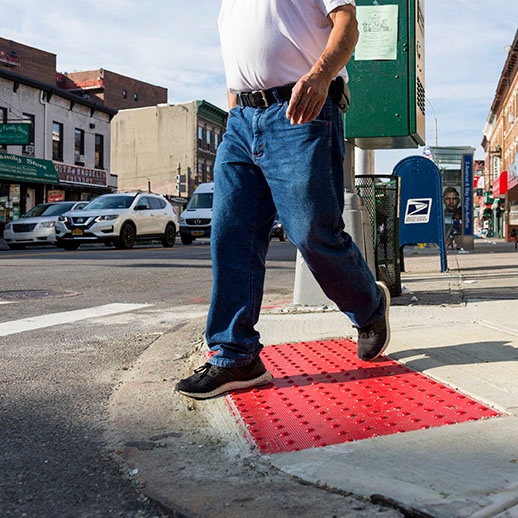Sidewalks are paths for the movement of people, generally run alongside a roadway, and provide access to buildings, parks, transit, and other destinations. Sidewalks also function as sites for loading and unloading vehicles, as places for outdoor dining and commerce, and as public meeting and gathering spaces. Sidewalks also serve as opportunities to locate other street improvements, such as stormwater management, plantings, and street furniture.
See Full Sidewalk in the Geometry chapter for more information about sidewalks.
Issues with pavement heaving due to tree root growth in limited soil volume are common and expensive to repair. Where feasible, use of suspended pavement systems should be considered. Suspended pavement systems can be used with all of the sidewalk materials featured in this section. See Soils in the Landscape Chapter
Unpigmented Concrete
Mixture comprised of cement(s), aggregate(s), water, and other chemical admixtures, smoothed and then allowed to harden, forming a solid sidewalk surface.
Pigmented Concrete (Dark)
Same mixture as unpigmented concrete, but with an added pigment for use in high-density commercial districts. Pigmented concrete can be treated with silicon carbide to add sparkle, making it a Distinctive material.
Pigmented Concrete (Historic Materials)
Same mixture as unpigmented concrete, but with an added pigment to simulate granite slabs or bluestone flags in historic districts, as per LPC guidelines, or in historic, non-landmarked neighborhoods, as per PDC guidelines.
Detectable Warning Surface
A detectable warning surface (DWS) provides a continuous detectable edge between the pedestrian circulation path and the roadway at a flush curb. The surface, in a color that contrasts with its surroundings, helps to guide persons who are blind or have low vision DWS may also be referred to as tactile domes or raised domes.
Concrete with Exposed Aggregate
Exposed aggregate, such as pebble-sized stone, can be added to unpigmented or pigmented concrete mixtures to create texture and increase the distinctive quality. Aggregates can vary in size and color to achieve different effects.
Concrete with Custom Scoring
Unpigmented or pigmented cast-in-place concrete scored with a pattern to achieve a distinctive look.
Hexagonal Asphalt Paver
Asphalt precast into hexagonally shaped paver. This material is primarily used on sidewalks adjacent to parks, and conveys park-like character.
Bluestone Flag
Historic stone unit paver with subtle variations in color, grain, and surface. The preservation and in-kind replacement of bluestone flags are typically required in new construction projects within historic districts; the installation of new bluestone flags is typically recommended in locations adjacent to existing bluestone.
Granite Slab
Historic stone paver, with varieties of color, texture, and veining. Can be cut to extremely large sizes to span underground vaults. The preservation and in-kind replacement of granite slabs are normally required in new construction projects within historic districts; the installation of new granite slabs is typically recommended in locations adjacent to existing granite.
Granite Block
Historic smooth-finish granite block unit pavers often referred to as “cobblestones,” commonly used throughout New York City in the nineteenth century. This treatment is for use in the furnishing zone and may also be used in plazas within landmarked districts.
Permeable Interlocking Concrete Paver (PICP)
Permeable Interlocking Concrete Pavers (PICPs) have voids at the joints to allow water to pass through into an open-graded reservoir below.
Precast Porous Concrete Panel (PPCP)
Concrete mixture using admixtures to allow a smaller amount of cementitious paste to coat the aggregate, and using little or no sand or fine aggregate, leaving substantial void content. This allows water to pass through to an open-graded reservoir underneath.
Asphaltic Concrete (Flexible Pavement)
Commonly known as asphalt, this material is a mixture of asphalt bitumen and stone aggregate, laid on an aggregate base and compacted by a roller to form a smooth and solid road surface.



